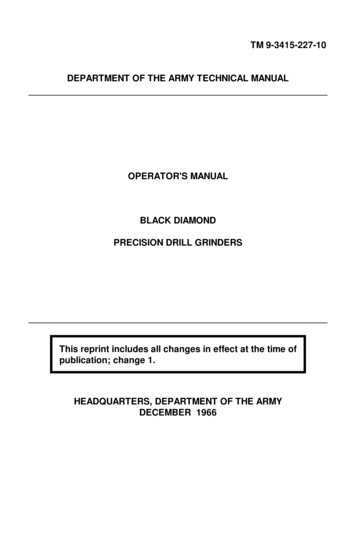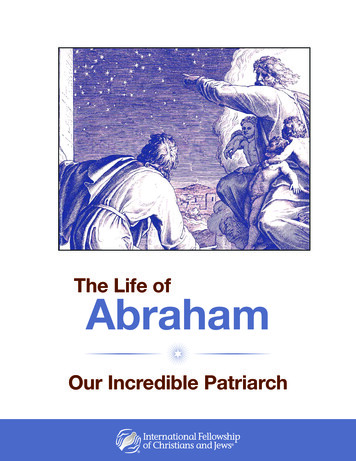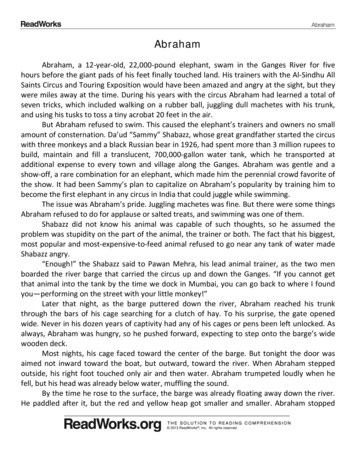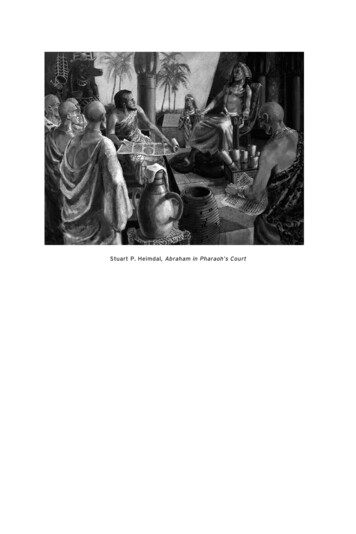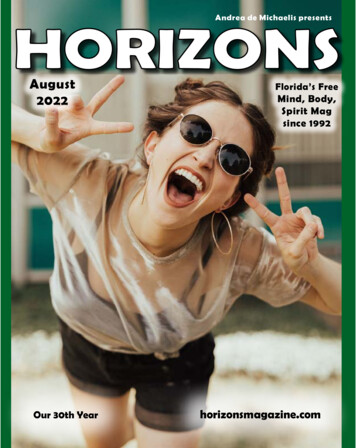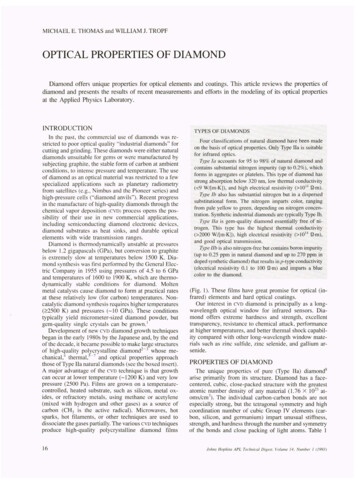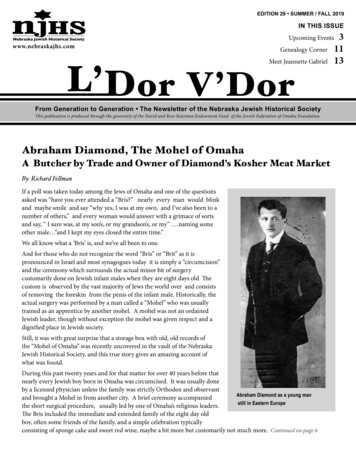
Transcription
EDITION 29 SUMMER / FALL 2019IN THIS ISSUENebraska Jewish Historical Societywww.nebraskajhs.com31113Upcoming EventsGenealogy CornerMeet Jeannette GabrielFrom Generation to Generation The Newsletter of the Nebraska Jewish Historical SocietyThis publication is produced through the generosity of the David and Rose Katzman Endowment Fund of the Jewish Federation of Omaha Foundation.Abraham Diamond, The Mohel of OmahaA Butcher by Trade and Owner of Diamond’s Kosher Meat MarketBy: Richard FellmanIf a poll was taken today among the Jews of Omaha and one of the questionsasked was “have you ever attended a “Bris?” nearly every man would blinkand maybe smile and say “why yes, I was at my own, and I’ve also been to anumber of others,” and every woman would answer with a grimace of sortsand say, “ I sure was, at my son’s, or my grandson’s, or my” .naming someother male ”and I kept my eyes closed the entire time.”We all know what a ‘Bris’ is, and we’ve all been to one.And for those who do not recognize the word “Bris” or “Brit” as it ispronounced in Israel and most synagogues today it is simply a “circumcision”and the ceremony which surrounds the actual minor bit of surgerycustomarily done on Jewish infant males when they are eight days old Thecustom is observed by the vast majority of Jews the world over and consistsof removing the foreskin from the penis of the infant male. Historically, theactual surgery was performed by a man called a “Mohel” who was usuallytrained as an apprentice by another mohel. A mohel was not an ordainedJewish leader, though without exception the mohel was given respect and adignified place in Jewish society.Still, it was with great surprise that a storage box with old, old records ofthe “Mohel of Omaha” was recently uncovered in the vault of the NebraskaJewish Historical Society, and this true story gives an amazing account ofwhat was found.During this past twenty years and for that matter for over 40 years before thatnearly every Jewish boy born in Omaha was circumcised. It was usually doneby a licensed physician unless the family was strictly Orthodox and observantand brought a Mohel in from another city. A brief ceremony accompaniedthe short surgical procedure, usually led by one of Omaha’s religious leaders.The Bris included the immediate and extended family of the eight day oldboy, often some friends of the family, and a simple celebration typicallyconsisting of sponge cake and sweet red wine, maybe a bit more but customarily not much more. Continued on page 6
The Importance of Donating to the NJHSArchival CollectionNebraska Jewish Historical Society2019NJHS OFFICERSPresident: Bob BelgradeVice President: Beth StaenbergSecretary: Rocky SternPast President: Sue MillwardFOUNDERSMary Fellman & Oliver PollakBOARD MEMBERSLarry AlbertJill BelmontJudy BrooksteinDanny CohnJeannette GabrielMichael GendlerDora GoldstromJanie KulakofskyRocky LewisVicki PerlmeterPAST PRESIDENTSJoanie BernsteinMidge BowersHelen EpsteinDebbi JosephsonIra NathanHelen RifkinOFFICE STAFFExecutive Director:Renee Ratner CorcoranAssistant: Kathy Weiner2By: Reneé CorcoranThe NJHS received an important donation from the family of a recentlydeceased member of our Jewish community. Stored in the corner ofa basement was memorabilia from Hiller Liquor Company. The CarlFrohm Archival Center had no records of such a business in our area.It was very exciting to not only add the business to our collection, butto learn and explore further what was called Omaha’s new up-to-datefamily liquor store.The Hiller Liquor Company was established at 1309 Farnam Street,opening to the public on Saturday, August 23, 1902. It was advertisedas, “the only place of the kind in the west undoubtedly the handsomeststore in Omaha.We are always grateful for these special donations that help in ofmission of preserve the histories of the Jewish families who settledin Nebraska and Council Bluffs, Iowa. The NJHS is always seekingpersonal and family papers as well as photographs and memorabiliaof synagogues, Jewish organizations and businesses of Nebraska andCouncil Bluffs, Iowa. Please contact the office at (402) 334-6441 ornjhs@jewishomaha.org for further information. Stored away, you mayalso have important information regarding the history of our Jewishcommunity.
UPCOMING EVENTS & PROGRAMSMark your calendars for these events!NJHS Annual MeetingSunday, October 202:00 - 4:00 p.m. JCC GalleryPlease mark your calendar for Sunday, October20th at the Omaha Jewish Community Centerfor the NJHS annual meeting. This year we willcelebrate the refurbishing of the Omaha Section ofthe National Council of Jewish Women exhibit, OurStory. The many photographs in the display share therecollections of Omaha’s Early Jewish Community.Special Exhibit TourSunday, November 31:00 - 3:00 p.m. Meet in UNO LibraryShirley Goldstein’s Immigrant Rights Legacy:Operation Exodus in OmahaWitness: The Art of Samuel BakRenowned artist and Holocaust survivor SamuelBak brings his work to the University of Nebraskaat Omaha (UNO). On Sunday, November 3, 2019at 1:00 to 3:00 the NJHS membership is invited to attend a special tour of the “Shirley Goldstein’s Immigrant RightsLegacy: Operation Exodus in Omaha” and the Bak exhibit, “Witness: The Art of Samuel Bak” Jeannette Gabriel, NJHSboard member and the Director of the UNO Schwalb Center of Israel and Jewish Studies, has offered to give us apersonal tour of both exhibits. Jeannette curated the Goldstein exhibit and the Schwalb Center is a cosponsor of theBak exhibit. Even if you have seen one or even both displays, it will be a special experience having Jeannette explainthe significance of the Goldstein materials and Bak’s paintings. We will meet in the UNO Library at 1:00 p.m.Bak’s art visualizes his Holocaust experience and Jewish life through the ages. His art melds different styles, oftenfeaturing surreal imagery. The exhibit spans five decades of Bak’s artistic journey, featuring pieces that have beenshown in major museums and galleries in cities such as Tel Aviv, New York, Paris and Rome.The exhibit is made possible by the UNO Sam and Frances Fried Holocaust and Genocide Academy and the Natanand Hannah Schwalb Center for Israel and Jewish Studies. “Witness: The Art of Samuel Bak” will be on displaythrough November 14.3
NJHS EVENTS & PROGRAMSKevee’s bus tour.Bus Tour of Old Jewish OmahaNJHS and Kevee Kirshenbaum conducted a bus tour of OldJewish Omaha with Temple Israel on Sunday, April 7, 2019.The event was coordinated by Mendy Halsted and MindiArmstrong.Mindy Armstrong, Kevee Kirshenbaum and Mendy Halsted.The tour took the group downtown past the first synagogue builtoin Nebraska by the Congregation of Temple Israel on 23rd andHarney Street. Then a drive by of the former B’nai Israel AdasRussia Synagogue on 18th and Chicago Streets and 18th andBurt Streets, the site where Beth Hamedrosh Hagadol stood.We continued north past the former Beth Hamedrosh AdasJeshurun on 25th and Seward. Before returning back to Templea drive past the old Dr. Sher home was included.The Boys of AZAMason Quintero, 94th Grand Aleph Godol (International AZAPresident) from Marbelhead, Mass visited Omaha recently.NJHS was invited to share artifacts and AZA history at therecent AZA Founders Day Meeting. Mason is pictured withJordon Raffel, Alpeh Godol, Mother Chapter AZA #1.Mason Quintero and Jordon Raffel4
WelcomeThe Nebraska Jewish Historical Society is deeply grateful to all thosethat are participating in the Life & Legacy Program. Thank you for yourcommitment to the future of the NJHS and our entire Jewish community.Michael & Sheri AbramsonJanie Fox KulakofskyBob BelgradeRochelle (Rocky) LewisSandra Belgrade*Mary-Beth MuskinMark & Jill BelmontJody & Neal (Buzz) MalashockBonnie BlochJon & Denise MeyersBeth BrodkeyRobert MeyersonRon Brodkey*Gary NachmanDaniel CohnE. R. NewmanNorman & Eunice Denenberg*Phyllis NewmanYonatan & Liz FeldsternSharee & Murray NewmanJoanne FreemanPatty NoggJerry FreemanSteve NoggLois Friedman*/ Scott FriedmanSusie NortonGary & Barbara GoldsteinAlan ParsowDonald E. GoldsteinCarol ParsowGail Goldstein RaznickMargo Frohman ParsowKathy GoldsteinVicki PerlmeterDora GoldstromAlan E. PotashSteven GottliebMarty & Iris RicksMary Sue GrossmanRosalie* & Milton Saylan*Bonnie Kuklin HorwichDenise SilvermanJon JabenisHarold SiporinGary & Karen JavitchCarolyn “Rocky” SternDebbi JosephsonHarry WeinerJeff KirshenbaumKathy WeinerJoe Kirshenbaum3 AnonymousSharon Kirshenbaum*In blessed memoryLetters of intent can be amended to include the Nebraska Jewish HistoricalSociety in your afterlife gifts. If you wish to change your letter of intentplease contact Margo Parsow at (402) 334-6432.to the NewestNJHS MembersWe gratefully acknowledgeand welcome the newmembers of the NJHS.Thank you for your generosityand support. Trenton B. MagidRecord Your StoryHave you recorded youroral history? It is one ofthe greatest gifts you cangive them. The NJHSoral history interviewsare a very importantand valuable part of ourarchival collection. If youor a family member wouldlike to record your history,contact the NJHS office at(402) 334-6442. Do it foryou, for your children andgrandchildren!5
“Abraham Diamond, The Mohel of Omaha” continued from pg 1But for nearly 40 years, that is from the late 1920s almostto 1960, every Jewish boy born in Omaha had a Bris,always on the eighth day of the child’s life unless medicalcircumstances required a delay, and the actual circumcisionwas performed by Omaha’s own Mohel, AbrahamDiamond.Rev. Diamond, the title was somewhat honorary, was aquiet and unassuming man. He was a butcher, a Kosherbutcher. He owned one of Omaha’s Kosher Meat Marketswhich in later years was known as Diamond’s Kosher Meatand Delicatessen located at 4415 Cuming, phone WA 5554,with its mottos on the door, “We Serve the Finest to theFinest.”In its earlier years it was located on North 24th Street inthe middle of the largely Jewish commercial neighborhoodof small individual enterprises operated by immigrantJews, mostly from Eastern Europe. A few doors southof Diamond’s on North 24th was Crounse’s Live Fish andGrocery, and to the north was Adler’s Bakery.Across the street from Diamond’s was Himelbloom’sBakery, with a deli on one side of it and a dairy store on theother. A few doors north were Shukert’s Butcher Shop,then Stoler’s Fish Market, then Glass the Butcher, and atClark Street Ratner’s Grocery. Up and down 24th Streeton both sides were more Jewish stores of almost everyimaginable type all the way to Lake Street.In addition to running his Kosher Meat Market, Rev.Diamond, the Mohel, kept a complete set of records ofeach Bris he performed, including the name of the babyboy in either Hebrew or Yiddish, the child’s father’s name,again in Hebrew or Yiddish but never in English, thedate of the Bris, often the name of the Biblical portionwhich was read that particular week in the synagogue,and usually the amount of money he received as a fee forperforming each Bris.These records of Rev. Diamond were written in his ownneat handwriting in small memo books, the type that formany years was commonly carried in a coat pocket or ina purse with names and phone numbers, short memo’sand miscellaneous information. There were four of thesememo books starting from 1926 and running through1959 carefully stored in the vaults of the Nebraska JewishHistorical Society.In many of the books, the fees Rev Diamond chargedare written in with the details of the individual Bris, butthere is also a separate memo book with more financialinformation. Each of these books are nearly similar in sizeand shape and color.In addition to the written records kept by Rev. Diamond,the Historical Society’s vault contains the actual operatinginstruments he used in performing each Bris. Mostnoticeable among the old set of instruments is the two
sided surgical knife, today called a scalpel, which issharp on both sides in case during the Bris one side isdetermined to be the slightest bit dull. Tradition saysthat each side must be sharp enough to scratch thesurface of the thumb nail of the mohel.A long time Omaha physician who during his yearsof practice performed many circumcisions carefullyexamined Rev. Diamond’s instruments and found thatthe major differences between those now in use andthose used by Rev. Diamond involved the clamp. Asimpler type was historically used by a mohel comparedto those currently used by physicians.There are strong traditions connected to the ceremonysurrounding the Bris.Historically the baby boy is held during the actualsurgical operation, and this honor is usually given to agrandparent or other relative. This person is called the“Sandak.” The actual chair the sandak sits in duringthe ceremony is called “Elijah’s” chair, named for theProphet. In addition, an honor is given to the personor persons who actually carry the baby in to the roomwhere the Bris will take place. This person is calledthe “K’vater” and the honor is akin to being the child’sGodparent. This honor, too, is customarily given to aclose relative of the baby.There is ancient history dealing with the Brit Melah,the Covenant of Circumcision and many traditionsabout the Bris. Jews the world over since the timeof Abraham in the biblical Book of Genesis havecircumcised all male infants when the child was eightdays old. As explained the person who does this bit ofminor surgery is called a “Mohel,” and the ceremonyitself is called a “Bris,” or more correctly a “Brit Melah.”The word “brit” means “covenant” in Hebrew whichexplains that the act of circumcision is part of acontract between God and Abraham which throughAbraham is to be carried on to all male children ofIsrael even to the present day. The Bris is often donein the family home though sometimes it’s done inthe synagogue or even in the hospital if the child iskept there for medical reasons. And unless there arehealth reasons to delay the bris it is always done onthe eighth day, counting the day of birth as the first day.The circumcision itself is performed regardless of whatelse might be taking place on the eighth day of the babyboy’s life, including the Sabbath and all holidays, eventhe holiest days of the year like Yom Kippur, the Day ofAtonement, and Rosh Hashanah, the New Year.The importance of the Covenant made between the Lordand Abraham concerning the circumcision of all malebabies can be understood best by the fact that directionsfor the Bris are written early in the Book of Genesis,preceded only by the stories of the Creation, the Garden ofEden, Noah and the Flood. After these primary episodescome the directions given to Abraham by the Lord whotells Abraham where he should live and how he shouldconduct his life.7
A page from theseparate memobook kept by Rev.Diamond containinga record of the fesshe charged. Thispage begins in theupper right corner inMarch, 1928, whenhis fees were wither 10 or 20. In 1929his fees droppedto 3, and even 1.Later the fees roseto 10.A typical page ofthe Memo Book keptthrough the years byRev. Diamond fromthe year 1937. Entry#91 in the upperright corner states:“the boy (ha-yaled)Friedel Joseph son(ben) Eliezer Simon(Fred Simon son ofLester Simon). Brison May 22, 1937. Theentry shows that afee of 10 was paid.Another typical pagemany years latershows in the lowerright corner theentry for the brosof Robert Freemanborn on January 31,1953, with a bris onFebruary 11. 1953,son of MenachemMendel Freeman,known as M. JerryFreeman.8Nearly every Jewish male child bornin Omaha from the 1926 to 1959 wascircumcised by Abraham Diamond.He was customarily referred to as Rev.Diamond, though the task of serving as amohel has always been considered to beone which is performed by a technicianrather than by a religious leader.But the importance of the ceremonywas never minimized. Neither was therequirement that the Mohel himself wasto be expert at his skill. No one everquestioned the technical skill of Rev.Diamond nor the seriousness with whichhe approached each infant and eachfamily.Still Mr. Diamond left a long legacy whichmen and women of Omaha well know.But what might surprise those Jewish menof Omaha who had a Bris performed byRev. Diamond and the Jewish women whostood and watched, sometimes holding ahand over their eyes to block them fromwatching their eight day old son goingthrough this short but painful operationas Rev. Diamond did his work, is thedetailed records he kept.These records together with theinstruments Rev. Diamond used arenow being held for safekeeping and forhistory by the Nebraska Jewish HistoricalSociety. They were left undisturbed in theSociety’s vaults until they were recently“discovered.”Abraham Diamond, the Mohel, earnedthe major part of his living as AbrahamDiamond, a Kosher Butcher, with hisbutcher shop in the middle of the Jewishcommercial neighborhood on North 24thStreet, just south of Clark Street. Theimmigrant Jewish community’s majorbusinesses were located on North 24thStreet starting near Cuming Street andextending north to Lake Street. And theDiamond butcher shop was in the middleof this area. This is where Mr. Diamondworked every day and made a living forhis family.
Not as an aside yet not as an afterthought but thishistorical article is also the family story of Mr. Diamondand his life, his wife Ida, his five sons Hy, Meyer, Isadore,Sam, and Stan, and his daughter, Shirley Trachtenbarg,Abraham Diamond was born in 1893 and died in 1962at the age of 69, and his wife, Ida, was also born in 1893but died in 1966 at the age of 73. They were each buriedin Omaha in Pleasant Hill Cemetery According to theobituary printed in the Omaha World Herald they wereaffiliated with B’nai Jacob Synagogue, one of the traditionalOrthodox shuls then in Omaha. None of their six childrenare now living, but they had 19 grandchildren. Years agothe Diamond family, when he was active as the Mohel ofOmaha, lived at 3012 Davenport Street, an area with manyJewish families a time.Further, his Kosher Meat Market on North 24th Streetwas once part of the commercial center of the immigrantOmaha Jewish community where Mr. Diamond workedevery day and made a living for his family.(On a personal note I recall as a child going to Diamond’sMarket with my mother and sometimes on Sundaymorning with my father. When they ordered Mr.Diamond took an entire salami or tongue or bologna orcorned beef, placed it in the big, silver colored hand meatslicer, and began slicing individual pieces of deli meat. Thefirst slice he made him always took in his hand, leaned overthe meat counter, and gave it to me, a child of 4 or 5 or 6.This made the trip to Diamonds exceptionally worthwhileto me. )Avram Yankel (his name as it was pronounced in Yiddish)and his wife Chaiya Yentil (again, in Yiddish) came toOmaha from a small village, a shtetl, in Latvia in the earlyyears of the 20th century. They had many relatives inOmaha, some who immigrated to Omaha about the sametime as they did and some of whom came as late as the yearsjust before World War II. The family names of relativesincluded, in addition to the Diamonds, the Blooms,(Lena Diamond was married to Sam Bloom), the Novaks,the Misles, and the Rubins. Abraham Diamond had twobrothers, Harry and William, and a sister, Lena. Many ofthe families were in the automobile business and some werein real estate. Abraham alone was a butcher, and he alone was a mohel.Through the years much has been written aboutcircumcision, Jewish practices and ceremonies about it, itsmeaning to the Jewish People, what it means to be a moheland how one becomes a mohel.One of the best and most complete definitions is thatof Rabbi Elliot Dorff who explained in “ModernConservative Judaism,” (2018, 105):“(The Bris) is the most ancient ritual we have, dating backto Abraham and our very beginning as a people. It is alsoa blood ritual, and the sign of the covenant imparted onthe male child is indelible. Most of all it expresses thesheer fact of continuity, of another link in the chain of thegenerations a ritual that will forever transform the verybody of the male Jew.”In a less serious manner, and with the humorous style heused in much of what he wrote, Leo Rosten in his classicbook, The Joys of Yiddish, ( 1968, 253):“A man passed a store window with nothing in it but aclock, stopped inside, and asked, “How long would it take tofix my watch?””How should I know?” shrugged the balaboss, (Yiddish forthe owner, one who is in authority). I don’t fix watches, I’ma mohel.”“But---in your window you have a clock!”“So what would you put in the window?”The serious and the humorous side of the subject, side byside, is a perfectly Jewish response.Illustrative of the present day seriousness of the artand science of being a mohel are the similar courses ofstudy and certification under the separate rabbinicalauthorization of both the Union of Reform Jews and theConservative group, the Rabbinical Assembly, through theJewish Theological Seminary. Each group operates its owntraining program and sets its own standards before it grantsauthorization to function under its auspices.But the basic requirements are similar. One must be alicensed physician with recognized hospital privileges,have a record of performing a given number of proceduresand carry adequate insurance. One must be Jewish and amember of a congregation of one of the groups and mustalso submit a letter of reference from the applicant’s rabbiin the applicant’s synagogue. The Union of OrthodoxCongregations does not have a formal training programbut uses instead the traditional method of certifying a newmohel by an experienced mohel as a sort of journeymanwith an apprentice. Today both the Reform and theConservative organizations provide for the training andcertification of women as a mohelet. In the major cities ofAmerica, and those with large Jewish populations, there areoften full time mohelim practioners, and in those areas withsmaller Jewish populations physicians who become a lay butcertified mohel often function.9
Does NJHS HaveYour CurrentE-mail Address?Is your e-mail addresscurrent? If you have a newe-mail address, or you haverecently changed providers,please let us know. Send ane-mail to Kathy Weiner atkweiner@jewishomaha.organd let her know yourupdated information. We aregoing to be electronicallysending e-mail from time totime, so please don’t be leftbehind! Send us your currentinformation today!Are You Moving?If you are moving residences,please notify us of youraddress change. Pleasecall the Nebraska JewishHistorical Society office at(402) 334-6441 or sendus an e-mail! Reach us atnjhs@jewishomaha.org.10As Rev. Diamond’s early records illustrate the average fee he chargedduring the 1930s, the years of the Depression, varied between 10 and 20, while in some cases it dropped to as low as 5 or even lower. Thereis no way to know if some were performed without a fee. Through theyears the fees Rev. Diamond charged gradually increased. Today typicalfees vary from 250 to 500. The director of the Reform group estimatedthat current charges “on the coasts average about 1,000 but in theMidwest the charges are more likely to be 500.” Rev. Diamond, it iscertain, would be aghast to hear of those numbers.The Jewish stores on North 24th Street are long gone, and the blockswhere they once existed are empty, empty of everything. The homesaround 30th and Davenport Street still exist, but the Jews who lived inthe neighborhood have moved farther and farther to the western reachesof Omaha. The Diamond grandchildren and now great-grandchildrenhave moved and are now all over the country.But still today, even though there are those who certainly do notremember their encounter with Rev. Diamond when they were eight daysold, they still understand that the Covenant that the Biblical Abrahamreceived and passed on as set forth in the Book of Genesis remains partof their body. The Bris continues as one of the strongest customs Jews inall ages throughout the world, in spite of adversity, have maintained.Note: Assistance in the preparation of this article has been given byProfessor Rami Arav of the Department of Religion and Philosophy,University of Nebraska at Omaha, and by Dr. James Wax, a long timeOmaha Pediatrician. Photography of the illustrations in this article wasdone by Reneé Ratner Corcoran. The photo of Rev. Abraham Diamondwas furnished by Steve Diamond of Denver, son of Hy Diamond, Rev.Diamond’s oldest son. Family lore was contributed by Brent Bloom,grandson of Lena Bloom, and Richard Diamond, grandson of WilliamDiamond, both of Omaha. The sketch of North 24th Street was madeby Harry and Doris Alloy of Omaha, Reference material was furnishedby Dr. Michael Miller, chair of the Brit Milah Board of Reform Jews,of Indianapolis, IN., Rabbi Ari Dembitzer, Beth Israel Synagogue, andRabbi Steve Abraham, Beth El Synagogue, both of Omaha.This article was written by Richard Fellman of Omaha,former newspaper reporter, retired lawyer, formerNebraska State Senator, elected member of the DouglasCounty Board of Commissioners and its chair, nomineefor the U.S. House of Representatives, and formerAdjunct Professor of the Department of Political Scienceat University of Nebraska at Omaha.
Genealogy CornerBy: Arnold Garson“How can I get started?” probably is the most frequentquestion in genealogy.You begin, obviously, by assembling all of theinformation you already have from your own knowledgeand from relatives: names, dates, places, events,documents, scrapbooks, and photos. Ask every questionyou can think of.But it won’t be long before you will want to begin searchingon the internet. This process can be confusing and timeconsuming, given that there are tens of thousands ofwebsites pertaining to genealogy. Cyndi’s List, a free onlinereference, contains links to more than 300,000 genealogydatabases in more than 200 categories. The key is to narrowyour focus, at least at first, to the websites that are likely tobe the most productive.So here’s a review of several of the best genealogy websites,both free and paid-access.You should consider using ancestry.com, which is themost useful and most comprehensive genealogy website.It contains billions of records, but you’ll have to pay a feeto use it. Most of the best and most productive genealogywebsites do charge a fee. Ancestry memberships start at 45a month and range up to 300 or more a year. You’ll easilyget your money’s worth; online name searches can producea huge range of documents.Another top website, familyserch.org, is free, maintainedby the Mormon Church. One of its benefits is access tothe incomparably valuable U.S. census records through1940, available most other places only through a paidmembership.There’s another free and website that is easily searched,while also being particularly relevant for readers here: theextraordinarily valuable and amazingly detailed Ellis Islandimmigration records (libertyellisfoundation.org). Examplesof things you may find in the Ellis Island ship manifests:How much money did your great-grandfather have on himwhen he came to America? What town did he come from,and in some cases, what was his street address in that town?With whom did he plan to live when he arrived in America?For most readers here, yet another free website that’sespecially important. Jewishgen.org includes, amongother things, comprehensive burial records for almost3.5 million Jews. Of particular note in this category are11,214 individual burial listings for nine Jewish cemeteriesin Omaha, two in Lincoln, three in Sioux City, and oneeach in Council Bluffs, Hastings, Grand Island, NebraskaCity, Scottsbluff, and Maxwell, Nebraska; 75 percent ofthese grave records include tombstone photos. JewishGenalso provides an unparalleled database of Jewish historyand genealogy records in Eastern Europe. Included, forexample, are the 1897 census of Russia, and the 1929 Polishbusiness directory with information for most cities, townsand villages – about 34,000 locations. There are countless,powerful narratives of 19th Century and early 20thCentury life and death in hundreds of shtetls. There’s also aHolocaust database.For those seeking translations of Hebrew tombstoneinscriptions, the Facebook page Tracing the Tribe – JewishGenealogy on Facebook is probably the easiest andquickest source, and it’s free. Just post a photo and wait fortranslations to arrive, often within minutes.After ancestry, familysearch, Ellis Island and JewishGen,my next choice would be a category of websites – historicnewspaper archives.Full disclosure: I spent my entire working career in thenewspaper industry – 46 years at the Omaha World-Herald,The Des Moines Register, The San Bernardino CountySun in California, the Argus Leader in Sioux Falls, SouthDakota, and The Courier-Journal in Louisville, Kentucky. Iworked for about one-third of my career as a reporter, aboutone-third as a supervisory editor, and about one-third as amedia company executive.Among the lessons from my career is that there may be noother place where more facts and interesting details aboutmore people have been recorded. Obituaries and weddingor engagement announcements are among the most obviousmass resource bases from newspapers, but there is so muchmore to be learned. Among my own discoveries: Inez Garson Perl, a first cousin once removed in Ithaca,New York, was an art historian. In 1957, she stunned theart world by fabricating an exhibit at Cornell Universitywith collages made by a fictitious 19th Century artist,Estaban Xiros. The exhibit drew numerous unsuspectingvisitors before being exposed as a hoax. The account of whathappened and how appeared in various newspapers underan Associated Press byline. Solomon Greenstone, my great-grandfather, lived inLincoln, where he operated a pawn shop, from his arrivalin the early 1880s until his death in 1909. Newspaperarticles gave me detailed glimpses of his life and activities.He fell on a si
20th at the Omaha Jewish Community Center for the NJHS annual meeting. This year we will celebrate the refurbishing of the Omaha Section of the National Council of Jewish Women exhibit, Our Story. The many photographs in the display share the recollections of Omaha's Early Jewish Community. Special Exhibit Tour Sunday, November 3



